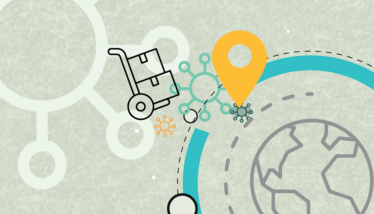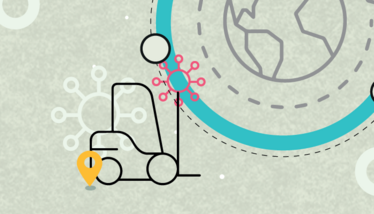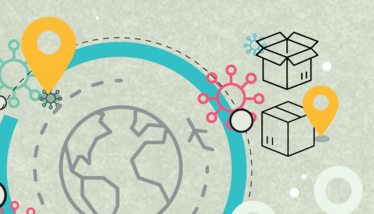
Mapping Out Material Resilience
A short guide to strengthening raw material supply chains
sponsored by Thermo Fisher Scientific
Since our earliest origins, we humans have come face to face with disasters and catastrophes; famines, floods , earthquakes, wildfires, wars, outbreaks of infectious disease – they’ve all brought the notion of resilience to the fore. Strategies exist to help us build resilience – broadly defined as the ability to bounce back from adversity or trauma. But how is the concept of resilience reflected in the biopharmaceutical industrial setting? Here, Luis (Lucho) Bianchi Pintos, Vice President of Procurement, BioProduction at Thermo Fisher Scientific, discusses what resilience looks like when sourcing – or providing – raw materials during a pandemic.
How is the industry being challenged by change?
Both the sourcing and supply of raw materials for many industries has been fundamentally challenged over the last few years – driven by the pandemic but also other trends. But the industry has not stood still; I have seen significant changes taking place to respond to these critical demands. Thermo Fisher Scientific works in the life science sector and we acutely understand the vital importance of maintaining our operations in the supply chains of medicines, medical devices, and medical research in times such as these. We work in a sector where technical specifications are highly regulated and offer little flexibility. In this world, it is of paramount importance that we have the right material resilience in place – and this remains the case even during a global crisis, such as a pandemic.

What does raw material resilience mean?
Resiliency can be defined in many ways, and there is more than one way to build it within a company, but the fundamental challenge for businesses is “change.” Change does not come easy in our industry. At a product level, the industry is usually steered away from change due to regulatory requirements. This in turn leads to a very narrow procurement process for raw materials – to the point where some organizations opt for a single source supply. With the pandemic pressurizing supply chains, you might think an obvious and easy fix would be to simply widen the sourcing of materials; however, to make that happen, an organization must restructure its thinking and operating practices – and that requires commitment.
The species that survive the longest are those that adapt the fastest, according to Darwin. And the pandemic presented a testing challenge, both at home and at work. For businesses, speed with which they adapt will almost certainly impact on their chances of survival. Pharma is not always used to change – but change we must.
Where do companies start the process of strengthening raw materials resilience?
Maintaining supply chains is very much about managing risk. Companies must identify risk, acknowledge its presence, and understand how it manifests across whole processes – a fine balancing act! It can be impossible to chase risk through multiple tiers of suppliers, but companies cannot just stop at their most immediate supplier. In some cases, companies might have to go deeper and collaborate even more closely with their partners to explore the tiers below. In my opinion, it’s important to ask questions. Who holds inventory or stock? Who can source alternative supplies? Do we build extra capacity? Do we have room to flex our specification requirements? When are the answers to these questions critical? A supply relationship is a mix of co-dependencies and it’s crucial to build in redundancies at strategic points.
There is also work to be done internally. Internal protocols, processes, and decision making must adapt – and I believe that raw material resilience must feature higher on agendas within an organization. Transparency throughout the whole process is key – whether internally or between the company and its suppliers. We must work together to ensure that products will still make it to patients. COVID-19 acted as a catalyst, exposing the weaknesses of organizations both internally and externally. To address these weaknesses, commitment, upper management drive, and extra crossfunctional resources must all come together in a time when everyone is focused on fire-fighting strained supply chains that cause day-to-day urgency.

What other considerations are key to building resilience?
Once you have addressed your internal constraints, mapped out your risk profile, and identified strategic weaknesses, you can then turn to strengthening those weaknesses. You will need to chase alternatives – alternative materials, alternative suppliers, and even alternative geographical locations. You also need to predict less obvious risks, such as site disruptions, and build in adequate redundancy.
Supply chains have historically been built to be efficient, narrow, and focused on driving down costs. But these features make them particularly inflexible and, therefore, breakable. We must move away from rigidity while accounting for risk. For instance, sourcing supplies from different countries at first appears a sensible solution – and though this approach does have several benefits, it can also be subject to geopolitical issues, macro-economic pressures, and even environmental challenges, which create risk and the potential for disruption. Therefore, choosing alternative suppliers in a way that balances these risks is important.
Are you proud of Thermo Fisher Scientific’s response to the challenges of a pandemic?
Yes. And I am amazed by what we have been able to accomplish given the size of the challenge – and in such little time! Thermo Fisher Scientific is a busy, fast-moving company with a strong belief in its mission to enable customers to make the world a healthier, safer, cleaner place for everyone. I feel everyone within the company rallied behind that as the pandemic closed in. Our customers had a crucial role to play in fighting COVID-19 – and that meant that our role in supporting them was crucial too. There is still a lot of work to be done, but we found that our suppliers rallied behind the call and prioritized efforts to secure and maintain a supply chain for essential healthcare products. We raised commitment throughout the company to address these issues head on and resourced multifunctional internal teams to identify, map, and tackle them with the support of our external suppliers. We continue to drive this support as far down the supply chain as we need to, helping at times our tier one suppliers with their own supply chain, reinforcing our ability to adapt.
Will resilience be a differentiator in the industry moving forward?
Absolutely. The pandemic has forced companies to acknowledge several weaknesses, but resilience in the supply of raw materials is an aspect that needs to be addressed urgently. From this point on, companies will need to have contingency plans that are tested, robust and in plain sight to give their commercial partners the necessary level of confidence. Having a secure, dependable supply chain policy will be a key differentiator of companies as we move out of the grip of this pandemic.
Our industry is highly regulated, and products have little tolerance in their composition. We must work together with full transparency to continue to deliver lifesaving biotherapeutics to patients. To do this, industry must build in alternative materials or supplies. With commercialized products already on the market, this is a big challenge. However, with products in development and particularly those at the research stage, manufacturers should instil a discipline to test supply chain resilience – and have a range of approved raw materials in their composition to enable multiple sourcing within the final product specification.




















